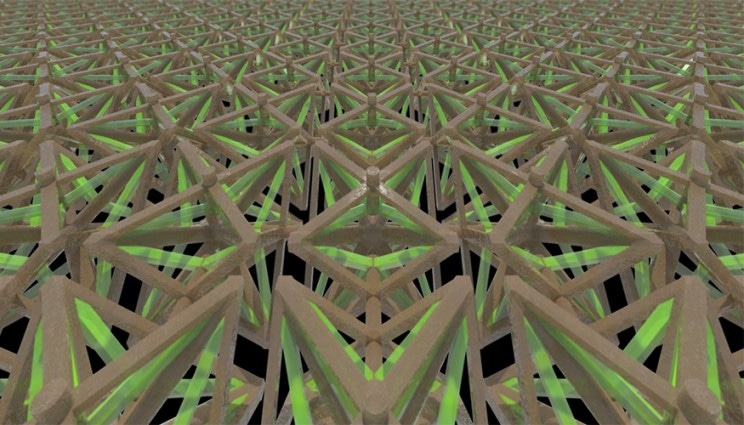Oct 25 2016
 LLNL researchers were part of a team that demonstrated a bi-material microlattice structure, 3D printed from polymer and a polymer/copper composite material, that can flex inward, causing the structure to contract when exposed to heat over a range of tens to hundreds of degrees Credit: Lawrence Livermore National Laboratory
LLNL researchers were part of a team that demonstrated a bi-material microlattice structure, 3D printed from polymer and a polymer/copper composite material, that can flex inward, causing the structure to contract when exposed to heat over a range of tens to hundreds of degrees Credit: Lawrence Livermore National Laboratory
3D printed materials with a unique property of shrinking when heated instead of expanding have been developed by a team of researchers, with members from Lawrence Livermore National Laboratory's Additive Manufacturing Initiative.
The Oct. 21 edition of the journal Physical Review Letters has published a study outlining 3D printing of lightweight metamaterials with negative thermal expansion that can be tuned to shrink over a wide range of temperatures. This explanation was provided by LLNL engineers in collaboration with scientists from MIT, the University of Southern California and the University of California, Los Angeles.
This is a new version of a printing method we have developed and used in the past. We used it to create a thermomechanical metamaterial that may enable applications not possible before. It has thermomechanical properties not achievable in conventional bulk materials.
Chris Spadaccini, Director, LLNL's Center for Engineered Materials and Manufacturing
In the paper, a bi-material microlattice structure was demonstrated by the researchers. This structure was printed from polymer and a copper/polymer composite material that has the potential of flexing inward, causing the structure to contract when exposed to heat over a range of tens to hundreds of degrees.
Researchers state that the study could be the very first experimental demonstration highlighting large tunability of negative thermal expansion (NTE) in three Cartesian directions of microlattice structures.
The researchers concluded that possible applications for the metamaterials could come in securing parts that could likely move out of alignment under different heat loads, including high precision optical mounts and microchips.
Traditionally, the way you compensate for (thermal mismatches) is with active control or heating and cooling, but what if you could design a material that would hold the object and passively adjust to local temperature changes?
Chris Spadaccini, Director, LLNL's Center for Engineered Materials and Manufacturing
Jonathan Hopkins, a former LLNL postdoctoral researcher who is currently an assistant professor of mechanical aerospace and engineering at UCLA, created similar structures in a separate paper using a human interaction-based approach instead of using a computer-driven approach. Hopkins joined the UCLA faculty in 2013 and won a Presidential Early Career Award for Scientists and Engineers (PECASE) in February for research directly connected to the recent paper.
"The interesting thing (about the structure) is it's made of two different materials, beams and void space," Hopkins explained. "When you heat it, as long as one of the beams expands more than the others, then the connecting points between each unit cell pulls inward and makes the overall lattice pull inward. It's an immediate thermal contraction, which is the unique thing about it."
Hopkins stated that the thermal expansion can also be positive or zero based on how the topology and geometry of the structure are engineered.
A group at MIT, headed by Associate Professor of Mechanical Engineering Nicholas Fang, used a projection microstereolithograpy process to 3D-print the microlattice structures. Qiming Wang, lead author of the paper and USC Assistant Professor of Civil and Environmental Engineering, worked as a postdoc for Fang.
Here we take advantage of projection microstereolithography 3D printing, but this time we expanded the system to be able to fabricate multimaterials; after you print out one material you switch to another. The challenge is you have to eliminate contamination between materials. If you don't wash out the residue after every layer, two materials will be mixed up.
Qiming Wang, Assistant Professor, USC
Wang pointed out the possibility of using the microstructured metamaterial in dental fillings, which are likely to crack or move when an individual eats something hot, in order to fill in tiny gaps in bridges or buildings that are generally left open to account for thermal expansion. The microstructured metamaterial can also be used as atomic-force microscopes in precision devices.
"The problem we're treating is a thermal mismatch problem," Wang said. "These materials have different thermal expansion coefficients, so once we increase the temperature, they interact with each other and pull inward, so the overall structure's volume decreases. The next step is to fabricate zero thermal expansion materials that could also solve these problems."
The work is part of a five-year Defense Advanced Research Projects Agency Defense Sciences Office program to research materials with controlled microstructure architecture.
Julie Jackson, LLNL engineer, and Qi Ge, MIT postdoc, are the other collaborators.